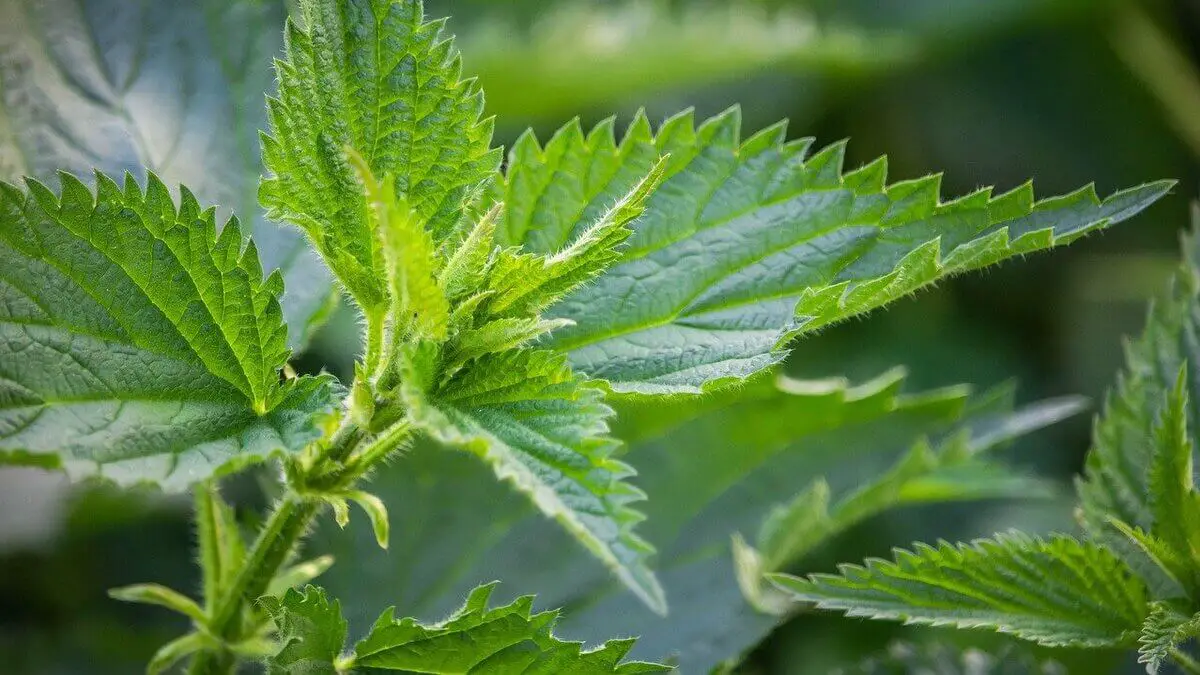Growing Stinging Nettle in the Gardens
Stinging nettle (Urtica dioica) also has many other names including common nettle, burn weed, burn nettle, and burn hazel. This is a perennial herbaceous plant belonging to Urticaceae (flowering plant) family. Normally, gardeners prefer growing stinging nettle for its Culinary usage.
This article focuses on growing stinging nettle in gardens, its propagation, harvest, and uses.
This plant is native to western North Africa, Europe, and temperate Asia. People all over the world prefer growing stinging nettle. Hence you can find them almost everywhere including North America and New Zealand.
It can spread through self-seeding and root mass. It can also neutralize easily. Due to these characteristics, some people in the US and other parts of the world consider this plant as Invasive.
Generally, this species is divided into six subspecies. Five of them have hollow stinging hairs referred to as trichomes, on the foliage. These hairs act like hypodermic needles and inject chemicals including histamine. These chemicals produce a stinging sensation on human skin.
Table of Contents
History
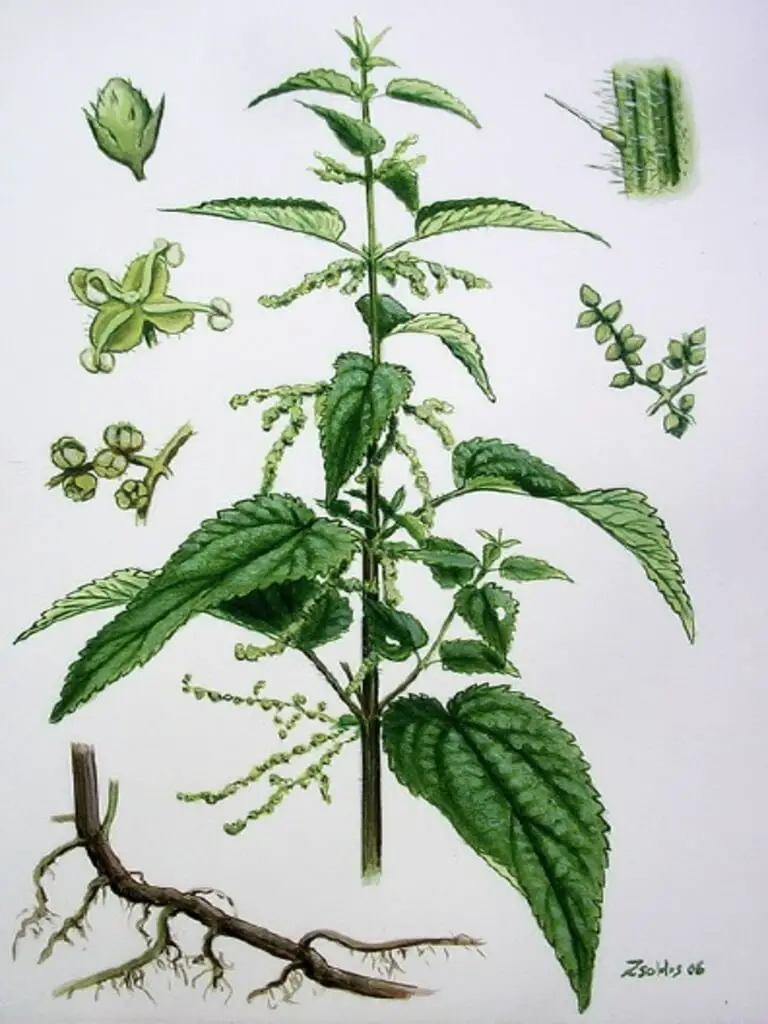
Photo by Zsoldos Márton (Wikimedia Commons) (CC BY-SA 3.0)
The documented evidence of the growing stinging nettle and its usage dates back to 1200 BC. Many ancient societies including Germanic Saxons and native Americans used stinging nettle for medicine, tea, food, and also for textile raw materials in the past.
Since the 16th century, Native Americans and Europeans used Nettle fabric for clothing requirements. Modern-day industries use this fabric for textiles like flax or hemp. The finished products may range from thick and rough to fine and soft.
Since the early 20th century, the Germans used Nettle fabric, mostly combined with cotton. They manufactured fabrics, stockings, and undergarments. In Modern days, they use these fabrics to manufacture a number of products including eco-friendly textiles
Description
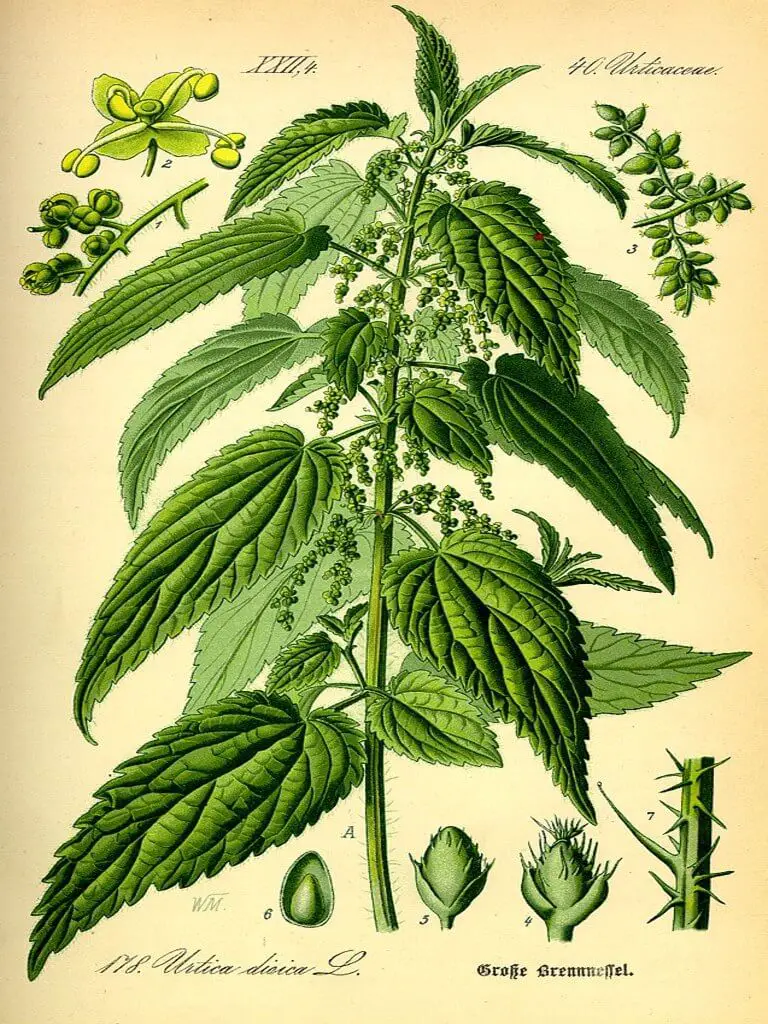
In General, stinging nettle is a perennial, herbaceous, dioecious plant. It grows 1-2 meters tall. The roots, rhizomes, and stolons are bright yellow in color.
The green, soft leaves are 3 -15 cm in length. They sprout oppositely on a wiry, erect, green stem. Naturally, these leaves have a cordate base, serrated margin, and an acuminate tip. This tip has a terminal leaf tooth comparatively larger than the adjacent laterals.
The leaf base bears numerous greenish or brownish small flowers (axillary inflorescences).
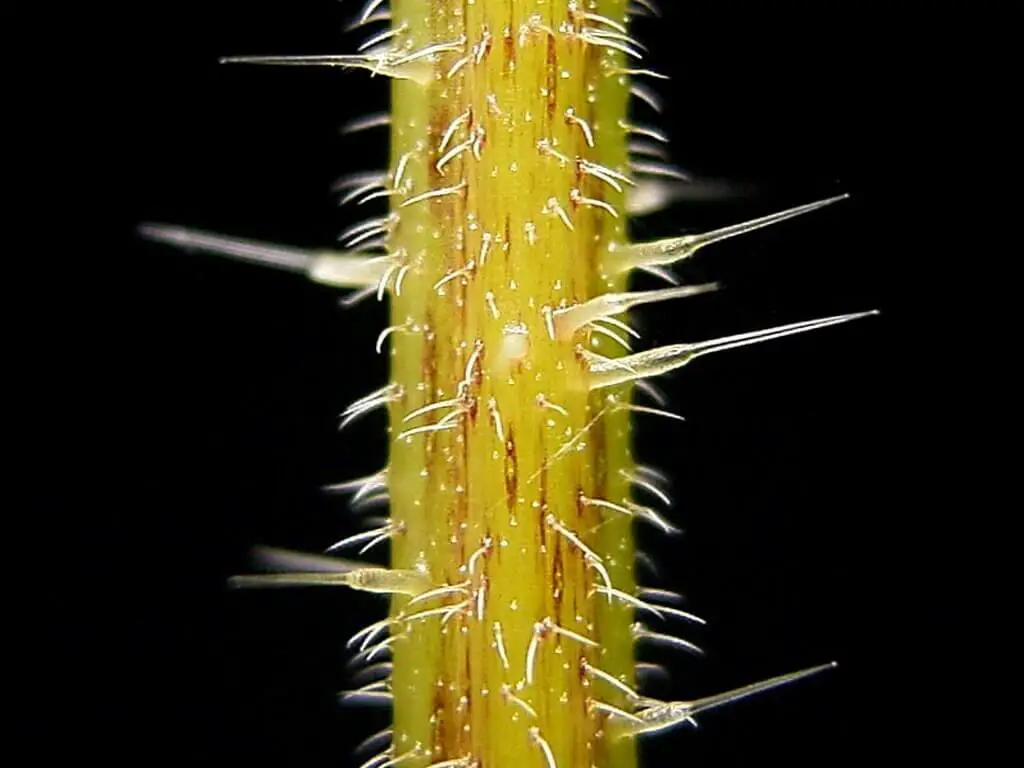
Photo by GFDL (Wikimedia Commons) (CC BY-SA 3.0)
Some subspecies have non-stinging hairs. However, most subspecies have stinging hairs (spicules or trichomes) on stems and leaves. If you touch them, they transform into hypodermic needles that inject chemicals including histamine. As a result, you may feel a painful sting or paresthesia. Thus, these plants got the name “stinging nettle”.
So, you have to careful while growing stinging nettle. Always use good quality garden gloves while dealing with stinging nettle plants.
As mention above, stinging nettle is a dioecious plant. It simply means, one Individual plant produces male flowers only, while the other individual plant produces female flowers only.
Generally, male flowers have stringy, compact flower clusters pointing upwards. Contrastingly, female flowers have dense, heavy clusters of flowers pointing downwards.
stinging nettle plants usually pollinate through the wind (Wind pollination).
Propagation
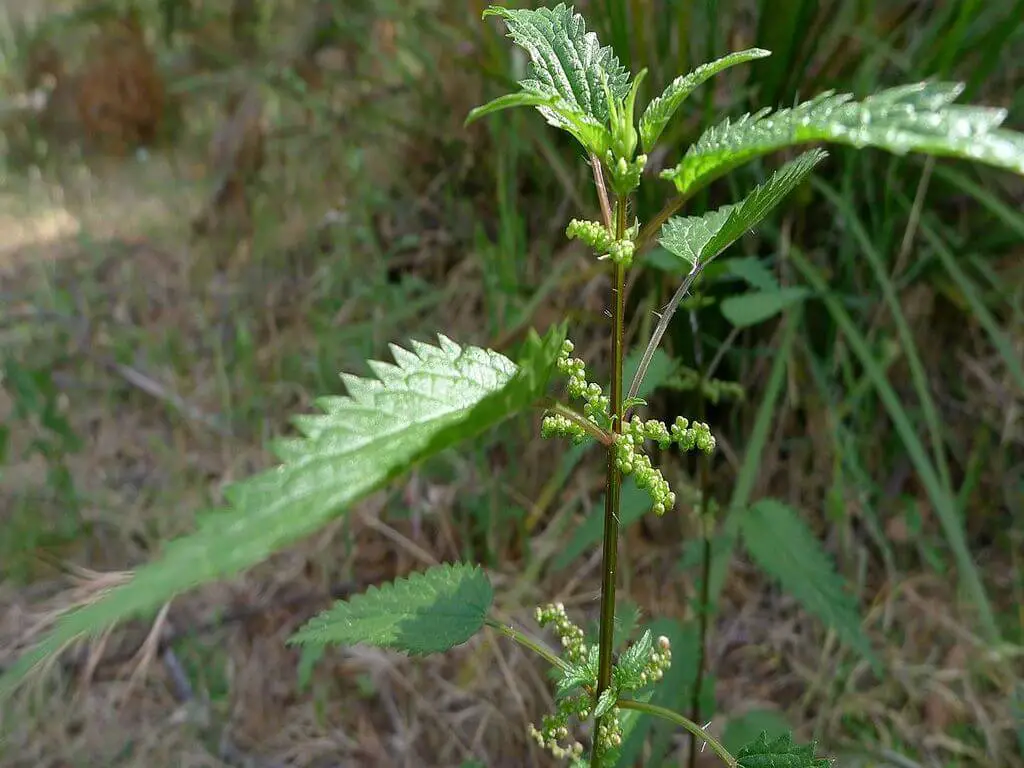
Photo by John Tann (Wikimedia Commons) (CC BY 2.0)
Stinging nettles grow well in full sunny or partial shaded areas. They require moist soil with a PH value between 5 to 8. Generally, stinging nettle plants flourish on soils that have rich nitrogen content. So, it is advisable to mix some composted manure to the soil, before planting these species. This plant adapts well in USDA zones 3-10
Growing Stinging Nettle from Seeds
You can purchase seeds from amazon or any online stores. Alternatively, if your garden already has growing stinging nettle plants, you can collect the seeds in the fall season. Make sure they have turned brownish in color. Store them in a jar separately.
Generally, these seeds are very tiny. For the germination process, they need light.
Start the sowing during the spring season. Sow the seeds 1/4 inch deep at most. It simply means, covers the seeds with a thin layer of soil. Germination can be predicted within a couple of weeks. After that, thin them an inch apart, pulling out the unhealthy ones.
Seedlings or Live plants
You can also purchase the Live plants online or any nearby nursery. You also have the option to grow them in pots or transplant them outdoors. If you prefer transplanting, do it during the early spring.
Because it is advisable to work the soil in the spring season for growing these plants. While planting, make sure the distance between each plant is 8 inches.
Growing Stinging Nettle from Divisions
Generally, growing stinging nettle from divisions is the most feasible method. It is because you can easily find many gardeners growing stinging nettle plants in your neighborhood. Just request them for a division. most probably they will accept with a smile!
Once these plants establish themselves, they spread very quickly. So, you can also happily help others for divisions in the future.
Alternatively, you can simply follow these livestock and find these plants easily in the woods, meadows, etc. This makes the job easier. Stinging nettle plants are forage plants. So, livestock use to graze them for food.
Just learn to identify them with visual cues rather than touching them.
Growing Stinging Nettle – Caring
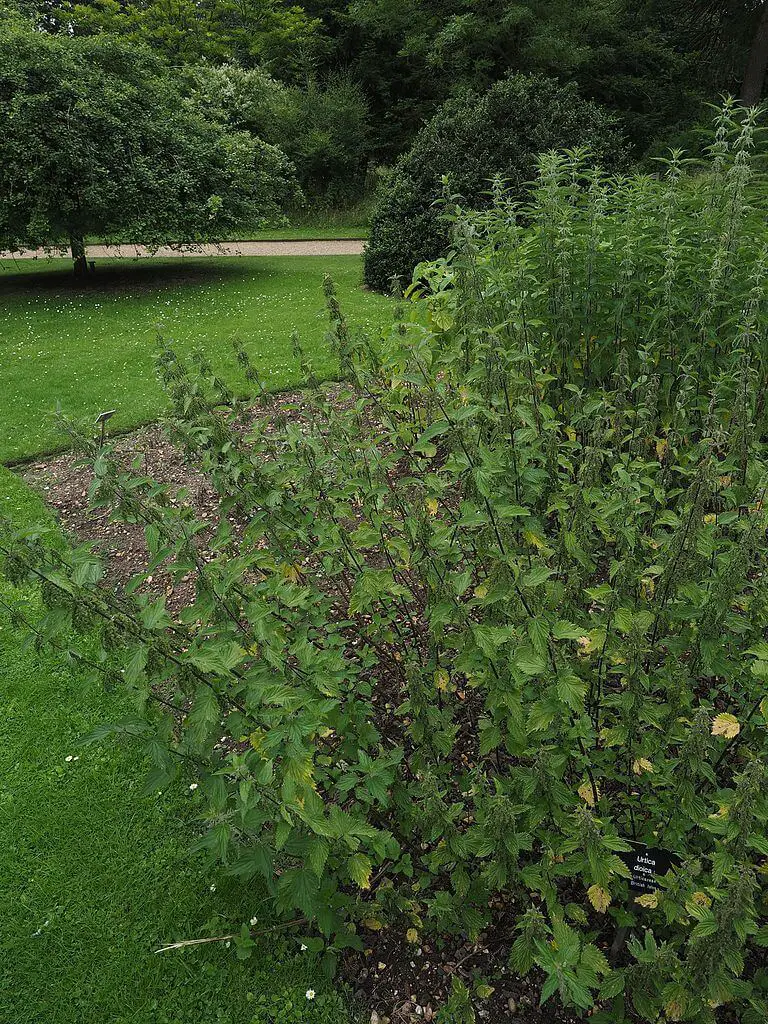
Photo by Verbcatcher (Wikimedia Commons) (CC BY-SA 4.0)
Stinging nettle plants are known for their hardy nature. Hence, growing them in adverse climates may not be a matter of concern. However, it needs some caring during the prolonged hot periods and dry atmospheres.
If the soil is too dry, these plants may struggle to grow and lack the flavor. This may lead to a discrete reduction in their well know herbal characteristics. So, water them occasionally during such times.
Normally, you can harvest these plants in the spring season. So, maintain the moisture content throughout the spring season, until you finish harvesting. After that, these plants can take care of themselves for the most part.
You can also use a good quality leaf mulch around the plants, to maintain the moisture content.
Harvest them regularly. This helps fresh new growth in the plants. However, keep a constant watch on their spread habits. If you see them spreading to new areas, just pluck them off. Otherwise, they may be a nuisance by invading the whole area little by little.
Pruning

Pruning periodically helps to keep the plant’s growth under check. Prune off the top portion of the plants by 1/3 using good quality garden shears. This helps to prevent the plant from growing too tall and bending down (toppling over) to the ground.
Leave the removed stems around the plants. The soil absorbs back the nutrients from them. This encourages the healthy growth of live plants.
Also, prune off the seed pods as they form. You can store these seeds to grow new plants. This also helps in the production of more yield next season, as the plant spends only a small amount of energy in seed production. In addition, this reduces the spreading intensity of the plant to a large extent.
During winters, these plants usually go dormant and the foliage dies back. This is not a matter of concern as the plants re-emerge and continue to grow during the following spring season.
Pests and Diseases
While growing stinging nettle plants, you may not have to worry about the infection of diseases and pests. This is because this plant tends to attract several beneficial insects and various butterfly species. In this way, the plant safeguards itself. As a result, the surrounding crops in the area also benefit from these beneficial insects.
Washington State University conducted studies on stinging nettle plants from 2011 to 2013 at three different locations in Yakima Valley.
Studies indicated these plants attracted 200 to 400 beneficial insects every year at every location. Some of the attracted beneficial insects include parasitic wasps, predaceous flies, predatory bugs, and native bees.
The studies concluded confirming the stinging nettle’s ability to serve as a natural biological control plant. Hence, the experts recommend growing these plants near vineyard habitat and butterfly conservation centers.
Growing Stinging Nettle Plants – Harvest
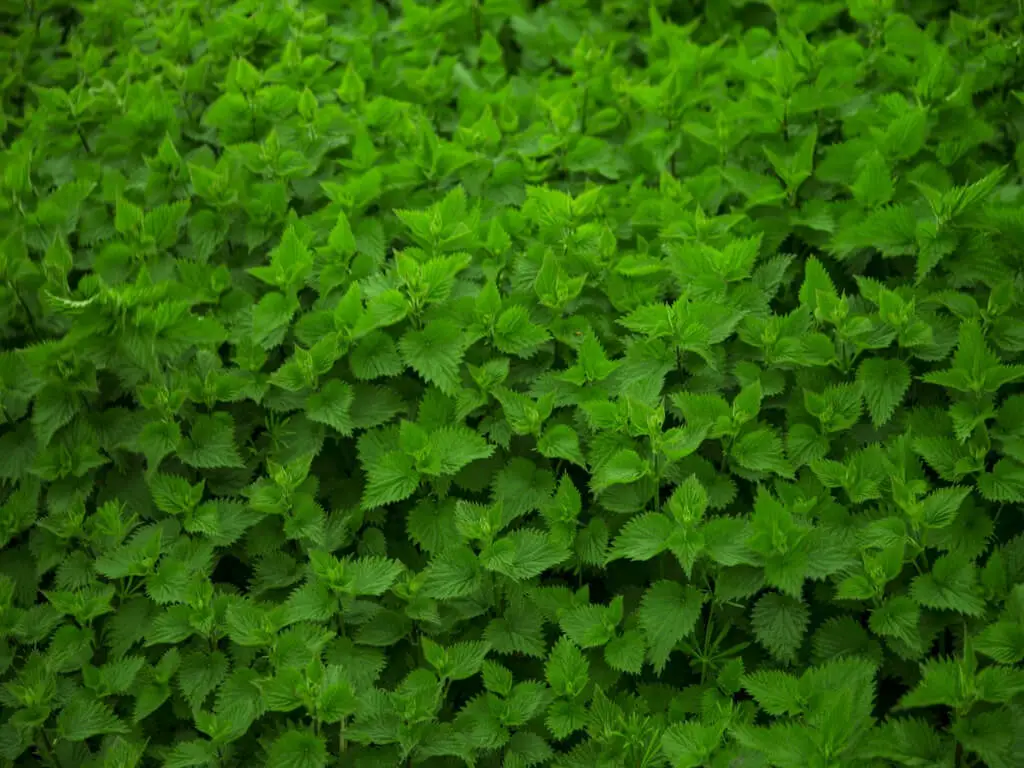
After growing stinging nettle for months, the time to harvest arrives with spring!
Don’t be frightened of the pesky needles. Just wear clothes covering the full body or full body coveralls, good quality garden gloves, and garden shoes covering whole feet. If you follow this, the needles and their chemicals won’t have a chance to harm you.
Use good quality garden shears to cut the parts of the plants. It is also advisable to use good quality garden gear to perform any garden-related activity.
If you desire to harvest for food or herbal medicines, cut the foliage before flowering. After flowering, the leaves become tough and stringy.
Always start the harvest from the top portion of the plant. It is because the needles normally point downwards towards the ground.
Preserving
Generally, you can preserve the fresh leaves and consume them in a number of ways.
Naturally, you can remove the stings by the Cooking, blending, drying, or crushing. After that, you can easily handle or consume the leaves as per your desire.
Just like any leafy green vegetables, you can use stinging nettle leaves for preparing almost any dish, both domestically and commercially.
You also have the option of storing fresh leaves in a refrigerator for about 3 – 4 days. While doing so, use a closed container. Otherwise, people may hurt themselves accidentally with the stings.
Drying
Tie the stems and hang them upside-down in small bundles. Do this in a dark, dry place that has good air circulation. Mostly, the leaves will dry completely in a couple of weeks. This duration may vary a little bit depending on the environment.
Alternatively, you can use a dehydrator to dry them easily. Place the leaves in a dehydrator and set the temperature to the lowest (about 95-degree Fahrenheit). This may take about a day, to completely dry the leaves.
After that, remove the dried-out leaves from stems and other debris. collect them in an airtight container. Place the container in a dark and dry place.
You can also ground the dry leaves into powder. Mostly, people use this powder in tea or in dishes. This powder can also serve as a good nutritional supplement.
Freezing
Prior to freezing, remove the strings attached to the leaves by blanching or other likely techniques.
For blanching, place the leaves in the boiling water for about 2 minutes. Then, douse them quickly in ice-cold water.
After that, drain the water and squeeze out the moisture. Store them in refrigerators using freezer bags.
You can add frozen nettles with any food that contains green vegetables. They enhance the flavor and add taste to the food. You can mix them handful in pasta, soups, egg omelets, Etc.,
Uses of Growing Stinging Nettle Plants
Growing stinging nettle (Urtica dioica) has numerous uses. Below, we’ve detailed some of them.
Culinary use
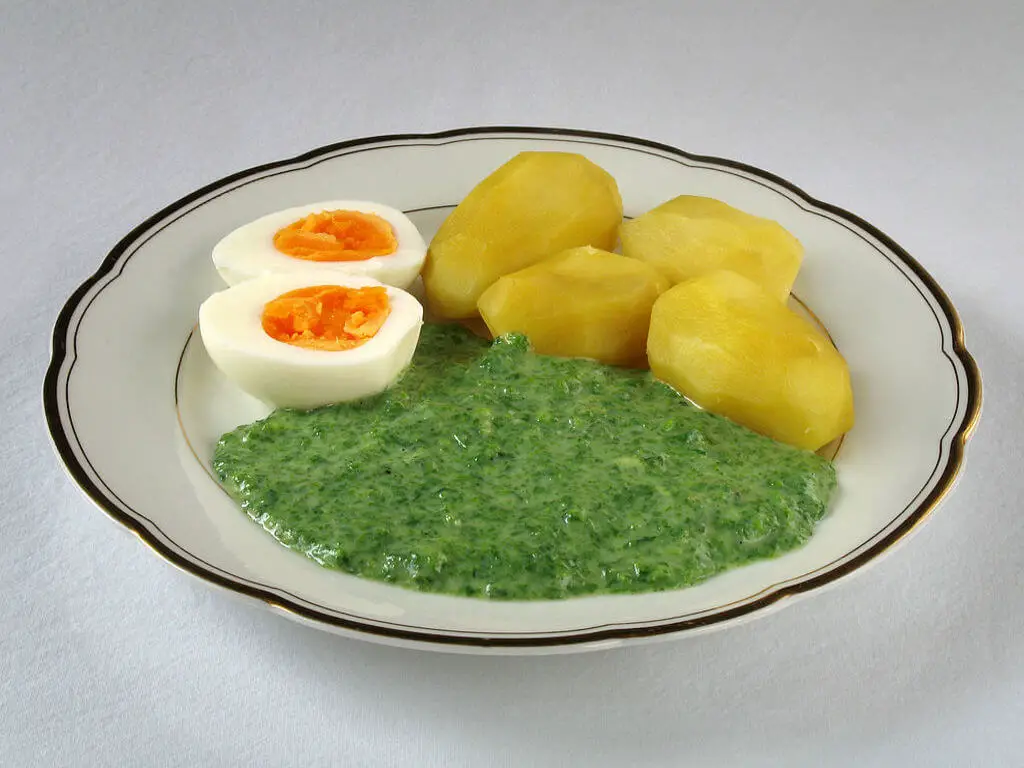
Photo by Kobako (Wikimedia Commons) (CC BY-SA 2.5)
Native Americans cooked Urtica dioica during the springtime when the availability of most other food plants decreases.
You can remove the stinging chemicals easily by soaking stinging nettles plant in water or cooking it.
When you cook Urtica dioica, it exhibits flavor similar to spinach leaves mixed with cucumber. it is rich in calcium, manganese, potassium, iron, vitamins A and C.
This plant contains at most 25% protein during its peak season. This is a very high amount compared to any other leafy green vegetable.
You can use Urtica dioica in several recipes, including purée, pesto, and polenta. Eastern and Northern European consumers use this plant in their famous Nettle soup.
Some people use Urtica dioica for cheesemaking. For example, The United Kingdom consumers use this plant as an ingredient in the production of Cornish Yarg (semi-hard cheese made from cow’s milk). The Netherlands consumers use this plant as a flavoring agent in some varieties of Gouda (mild-flavored cheese made from yellow cow’s milk).
Albania consumers use Urtica dioica as an ingredient in dough filling paste for börek (baked filled pastry). They pick out top baby leaves, simmer them and mix them with other ingredients in the dough filling paste.
Similarly, Greek consumers use Urtica dioica plant to prepare fillings for hortopita (greek savory pie)
Other uses
Traditional Medicine
Urtica dioica is one of the nine plants invoked in the 10th-century traditional medicine guide, Nine Herbs Charm
Textiles
The stems of Urtica dioica has blast fiber. Traditionally, people use this fiber just like linen for textile purposes.
Gardening
Urtica dioica plants have a number of uses in the garden industry. They serve as natural biological control plants by attracting beneficiary insects.
Nutrient Contents
The leaves of Urtica dioica contain about 0.7 to 3.3% fat, 5.5% protein, 7.1% carbohydrates, 17.6% dry matter, and 82.4% water. The Mature leaves have approximately 40% α- linolenic acid, which is an important omega-3 acid.
Hence, this plant can supply nutrients amply.
Poultry Feed
Some poultry farmers use Urtica dioica as a natural egg yolk colorant in laying hens. This natural colorant does not have adverse effects on health like some artificial pigments.
Mammal Feed
Normally, herbivorous mammals avoid the intake of fresh stinging nettles. However, when the nettles become dry or wilted, these mammals’ intake them voluntarily.
Final Thoughts on Growing Stinging Nettle Plants
Growing stinging nettle in gardens has much more to offer. Some see them as irritating weeds. But just learn to handle these plants, you will love them for their offerings.
They are cheap to buy, easy to maintain, and support humans in many forms. What more could one ask for, from a perennial herbaceous plant? Just taste a cup of nettle tea, you will start to like this plant like most of us do!
Similar Plants
Growing Cumin in Garden
Growing Chicory Plants in Gardens

